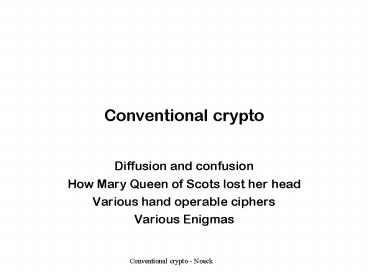Conventional crypto - PowerPoint PPT Presentation
Title:
Conventional crypto
Description:
This is actually a copy of the machine conceived by Turing ... Only one simple shifted translation alphabet. Relatively short period ... – PowerPoint PPT presentation
Number of Views:74
Avg rating:3.0/5.0
Title: Conventional crypto
1
Conventional crypto
- Diffusion and confusion
- How Mary Queen of Scots lost her head
- Various hand operable ciphers
- Various Enigmas
2
Confusion and diffusion
- Confusion
- Replacing one element by another of the same
size, seemingly randomly chosen - The substitution must be one-to-one so it can be
undone - Diffusion
- Permuting the elements from place to place in a
seemingly random fashion - Permutations rather than random scrambles must be
used so the rearrangement can be undone - Expansion and hiding
- Ciphers that dont expand the text rely on
confusion and diffusion - Concealment ciphers bury the content in noise or
nondata
3
Confusion methods
- Monoalphabetic substitution
- Trivial example Caesar cipher
- He replaced each letter of the plaintext by one
three letters before - Weakness is the fixed scheme once diagnosed,
the Gauls win - Fairly trivial example randomly chosen permuted
alphabet - 26! Of these alphabets exist a very large
number - Frequency table is used to break this one
plaintext has nonuniform distribution of
characters and diphthongs - Polyalphabetic substitution
- A sequence of permutation alphabets is used
- Methods include
- Vigenere table (very simplistic)
- Code strips and such (bulky)
- Rotor machine
4
Comments on permutations
- A permutation is
- A one-to-one mapping of a set onto itself
- With the underlying operation it forms a group
(more later) - A permutation of a permutation is still a
permutation - An substitution alphabet is a permutation, but
the resulting cipher is not a permutation - Permutations have unique inverses
- The simple transposition ciphers are permutations
5
Diffusion methods
- Transposition ciphers
- General idea is to rearrange the characters
without changing them to produce a
random-appearing text. - Example Playfair cipher named for its inventor
6
Monoalphabetic cipher example
- Note the use of the frequency table
- A bit easier Excel wasnt available in those
days - These often have nonstandard letter frequencies
- Also they have blanks
7
How Mary Queen of Scots lost her head
Note This is nothing but a monoalphabetic
cipher with some word substitution
From Singh, Simon, The Code Book
8
The 4-rotor Enigma, with wiringpictures from
Budiansky, Stephen, Battle of Wits
- Uses the polyalphabetic principle
- Repositioning the rotors gives a new alphabet
- The rotors are stepped at each character
- It was broken at least partly because of operator
carelessness
9
The Bombe , used to break Enigma messages
- Comments
- This is actually a copy of the machine conceived
by Turing - It still used a plugboard approach rather than a
strictly electronic stored program - Material captured from ships and submarines was
also used - This was a combination of known plaintext and
brute force cryptanalysis - It is not a Turing machine in the computer
science sense
picture from Budiansky, Stephen, Battle of Wits
10
The Vigenere table and an example
- Weaknesses
- Only one simple shifted translation alphabet
- Relatively short period
- Can be broken by frequency analysis of spaced
groups - Could be strengthened somewhat with a longer
keyword and different alphabets































